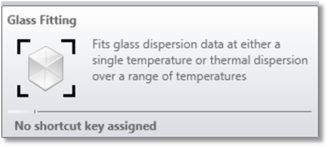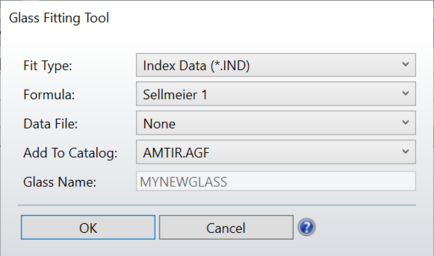Glass Fitting


Fits glass dispersion data at either a single temperature or thermal dispersion over a range of temperatures.

Fit TypeChoose either Index Data or Thermal Index Data.
FormulaChoose the name of the desired glass dispersion formula. For a complete description of the formulas, see "The glass dispersion formulas".
Data FileThe name of the data file that contains the dispersion data. When fitting index data, the file extension is IND. For thermal index data, the file extension is TID. See the discussion below for information on the file formats.
Add To CatalogIf "none" is selected the data will be fit and a report generated, but the data will not be added to a catalog. If a glass catalog name is selected, then the fit data will be added to the specified catalog. Note that adding glass data to a catalog that is supplied with OpticStudio is not allowed, therefore only the names of catalogs not supplied with OpticStudio are listed. If no catalog is listed, then a new catalog must first be created. For information on doing this, see "Creating a new catalog".
Glass NameThe name of the glass to add to the selected glass catalog.
Discussion
There are two different file formats and fitting algorithms supported by this feature. For index data, the text file should end in the extension IND. The first line of the file should contain the word TEMPERATURE followed by the temperature of the glass in degrees Celsius at which the data was measured. The next line should contain the word PRESSURE followed by the ambient air pressure in atmospheres. If one or both of these lines are omitted the default values are 20 degrees and 1.0 atmospheres. The remaining lines consist of two columns of data: wavelength and index. The wavelength values are in micrometers, measured in air at the specified temperature and pressure. The index must be relative to air at the temperature and pressured defined by the first two lines. OpticStudio will automatically convert the wavelength and index data to be relative to air at a pressure of 1.0 atmospheres at the reference temperature before fitting. A sample file might look like this:
TEMPERATURE 20 PRESSURE 1.0 0.3500000 1.5391663 0.4500000 1.5253195 0.5500000 1.5185224 etc...
For index data, the maximum number of points allowed to be fit is 1000.
For thermal index data, the text file should end in TID. The first line should contain the word PRESSURE followed by the ambient air pressure in atmospheres. If this value is omitted, the default value is 1.0 atmosphere. The remaining lines consist of three columns of data: temperature, wavelength, and index. The temperature of the first data point defines the reference temperature for the glass. It is important that the reference temperature data be listed first. Data for other temperatures should be listed in subsequent lines. All temperatures are measured in degrees Celsius. The wavelength values are in micrometers, measured in air at the reference temperature and pressure. The index values at the temperature of each data point must be relative to air at the pressure defined by the PRESSURE argument and at the reference temperature for the glass. OpticStudio will automatically convert the wavelength and index data to be relative to air at a pressure of 1.0 atmospheres before fitting
. A sample file might look like this:
PRESSURE 0.0 20.0000000 0.3500000 1.5391663 20.0000000 0.4500000 1.5253195 20.0000000 0.5500000 1.5185224 20.0000000 0.6500000 1.5145203 etc... -20.0000000 0.3500000 1.5391663 -20.0000000 0.4500000 1.5253195 -20.0000000 0.5500000 1.5185224 -20.0000000 0.6500000 1.5145203 etc... 40.0000000 0.3500000 1.5391663 40.0000000 0.4500000 1.5253195 40.0000000 0.5500000 1.5185224 40.0000000 0.6500000 1.5145203 etc...
The maximum number of points for the reference temperature fitting is 1,000. The total number of points for all temperatures and wavelengths that may be fit is limited only by available memory. Note that the fit will only be as good as the data provided. At least 6 points should be used at each wavelength, and preferably more than 12. At least 6 different temperature values should be provided. Using more than about 30 points at any one temperature tends to only increase the fit time and does not improve accuracy of the fit.
As with all fitting of data, the resulting fit should be carefully checked for suitable accuracy before using the data. It is particularly important to look at the fit index data at temperatures and wavelengths not included in the fitted data, because dispersion formulas can diverge somewhat from reasonable values between data points if the data points are sparse.
Both the IND and TID files should be placed in the folder <glass> (see "Folders").
Next:


